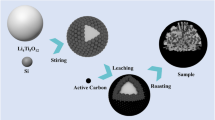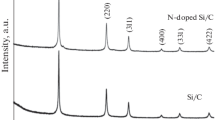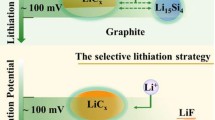Abstract
Nonstoichiometric microstructured silicon suboxide (SiOx) could be an attractive alternative to graphite as the anode materials of lithium-ion batteries (LIBs) due to its high theoretical capacity and low cost. However, practical applications of SiOx are hampered by their inferior inherent conductivity and distinct volume changes during cycling. In this work, in order to address these issues simultaneously, we designed and fabricated SiOx-based anode materials with TiO1−yNy-carbon coating layer (SiOx@TiON-C) using a scalable solvothermal and thermal reduction method. Our systematic investigations suggest that TiO1−yNy and the C coating layer could accommodate large volume variation and promote electrical conductivity of SiOx during cycling, respectively. As a result, the as-prepared SiOx@TiON-C anode exhibits superior lithium storage performance. Specifically, the resultant SiOx@TiON-C anode could deliver an outstanding reversible capacity of 750.2 mA h g−1 at 500 mA g−1 after 500 cycles, high initial Coulombic efficiency of 75.1% and excellent rate capability. This work offers a promising approach to promote the practical commercialization of microstructured SiOx-based anode materials for next-generation LIBs.

摘要
非化学计量微米氧化硅(SiOx)由于其高理论容量和低成本, 有望 成为锂离子电池石墨负极材料的替代品. 然而, SiOx 的实际应用仍然受 到其较差的固有导电性和循环过程中明显的体积变化的阻碍. 在本工 作中, 为了同时解决这些问题, 我们使用可规模化的溶剂热和热还原方 法制备了具有TiO1−yNy-C涂层的SiOx 基负极材料(SiOx@TiON-C). 我们 通过系统性研究发现, TiO1−yNy-C涂层可以适应SiOx 循环过程中大的体 积变化且有效提高其导电性. 因此, SiOx @TiON-C负极具有突出的储锂 性能. 具体而言, SiOx@TiON-C负极可以在500 mA g−1 的电流密度下循 环500圈后仍保持750.2 mA h g−1 的优异可逆容量, 75.1%的初始库仑效 率和优异的倍率性能. 这项工作为促进下一代锂离子电池微米SiOx 基 负极材料的实际商业化提供了一种很有前途的方法.
Similar content being viewed by others
References
Chen S, Dai F, Cai M. Opportunities and challenges of high-energy lithium metal batteries for electric vehicle applications. ACS Energy Lett, 2020, 5: 3140–3151
Li S, Wang K, Zhang G, et al. Fast charging anode materials for lithium-ion batteries: Current status and perspectives. Adv Funct Mater, 2022, 32: 2200796
Liang Y, Zhao CZ, Yuan H, et al. A review of rechargeable batteries for portable electronic devices. InfoMat, 2019, 1: 6–32
Mo R, Li F, Tan X, et al. High-quality mesoporous graphene particles as high-energy and fast-charging anodes for lithium-ion batteries. Nat Commun, 2019, 10: 1474
Ge M, Cao C, Biesold GM, et al. Recent advances in silicon-based electrodes: From fundamental research toward practical applications. Adv Mater, 2021, 33: 2004577
Zhang C, Wang F, Han J, et al. Challenges and recent progress on silicon-based anode materials for next-generation lithium-ion batteries. Small Struct, 2021, 2: 2100009
Zhao Z, Chen F, Han J, et al. Revival of microparticular silicon for superior lithium storage. Adv Energy Mater, 2023, 13: 2300367
Feng K, Li M, Liu W, et al. Silicon-based anodes for lithium-ion batteries: From fundamentals to practical applications. Small, 2018, 14: 1702737
Li H, Chen Z, Kang Z, et al. High-density crack-resistant Si-C micro-particles for lithium ion batteries. Energy Storage Mater, 2023, 56: 40–49
Wang J, Huang W, Kim YS, et al. Scalable synthesis of nanoporous silicon microparticles for highly cyclable lithium-ion batteries. Nano Res, 2020, 13: 1558–1563
Liu Z, Yu Q, Zhao Y, et al. Silicon oxides: A promising family of anode materials for lithium-ion batteries. Chem Soc Rev, 2019, 48: 285–309
Lee BS, Oh SH, Choi YJ, et al. SiO-induced thermal instability and interplay between graphite and SiO in graphite/SiO composite anode. Nat Commun, 2023, 14: 150
Chung DJ, Youn D, Kim JY, et al. Topology optimized prelithiated SiO anode materials for lithium-ion batteries. Small, 2022, 18: 2202209
Xu Q, Sun JK, Yu ZL, et al. SiOx encapsulated in graphene bubble film: An ultrastable Li-ion battery anode. Adv Mater, 2018, 30: 1707430
Tao J, Liu L, Han J, et al. New perspectives on spatial dynamics of lithiation and lithium plating in graphite/silicon composite anodes. Energy Storage Mater, 2023, 60: 102809
Xu Q, Sun JK, Yin YX, et al. Facile synthesis of blocky SiOx/C with graphite-like structure for high-performance lithium-ion battery anodes. Adv Funct Mater, 2018, 28: 1705235
Yang J, Wang Y, Li W, et al. Amorphous TiO2 shells: A vital elastic buffering layer on silicon nanoparticles for high-performance and safe lithium storage. Adv Mater, 2017, 29: 1700523
Han M, Mu Y, Yuan F, et al. Vertical graphene growth on uniformly dispersed sub-nanoscale SiOx/N-doped carbon composite microspheres with a 3D conductive network and an ultra-low volume deformation for fast and stable lithium-ion storage. J Mater Chem A, 2020, 8: 3822–3833
Zhang YC, You Y, Xin S, et al. Rice husk-derived hierarchical silicon/nitrogen-doped carbon/carbon nanotube spheres as low-cost and high-capacity anodes for lithium-ion batteries. Nano Energy, 2016, 25: 120–127
Fang H, Gao S, Ren M, et al. Dual-function presodiation with sodium diphenyl ketone towards ultra-stable hard carbon anodes for sodium-ion batteries. Angew Chem Int Ed, 2023, 62: e202214717
Wang J, Liao L, Li Y, et al. Shell-protective secondary silicon nanos-tructures as pressure-resistant high-volumetric-capacity anodes for lithium-ion batteries. Nano Lett, 2018, 18: 7060–7065
Xiao J, Han J, Kong D, et al. “Nano-spring” confined in a shrinkable graphene cage towards self-adaptable high-capacity anodes. Energy Storage Mater, 2022, 50: 554–562
Li Z, Zhao H, Lv P, et al. Watermelon-like structured SiOx-TiO2@C nanocomposite as a high-performance lithium-ion battery anode. Adv Funct Mater, 2018, 28: 1605711
Dou F, Shi L, Song P, et al. Design of orderly carbon coatings for SiO anodes promoted by TiO2 toward high performance lithium-ion battery. Chem Eng J, 2018, 338: 488–495
Chen TT, Liu HP, Wei YJ, et al. Porous titanium oxynitride sheets as electrochemical electrodes for energy storage. Nanoscale, 2014, 6: 5106–5109
Wang SE, Kim MJ, Lee JW, et al. A novel high-performance TiO2−x/TiO1−yNy coating material for silicon anode in lithium-ion batteries. Small Methods, 2022, 6: 2200430
Peng J, Li W, Wu Z, et al. Si/C composite embedded nano-Si in 3D porous carbon matrix and enwound by conductive CNTs as anode of lithium-ion batteries. Sustain Mater Technol, 2022, 32: e00410
Hu G, Zhong K, Yu R, et al. Enveloping SiOx in N-doped carbon for durable lithium storage via an eco-friendly solvent-free approach. J Mater Chem A, 2020, 8: 13285–13291
Liu L, Zhong X, Li M. Synergistic effect of TiO2 and TiN on the electrochemical performance of SiO as anodes for lithium ion battery. J Mater Sci, 2021, 56: 7587–7597
Xue H, Cheng Y, Gu Q, et al. An SiOx anode strengthened by the self-catalytic growth of carbon nanotubes. Nanoscale, 2021, 13: 3808–3816
Xu W, Tang C, Huang N, et al. Adina rubella-like microsized SiO@N-doped carbon grafted with N-doped carbon nanotubes as anodes for high-performance lithium storage. Small Sci, 2022, 2: 2100105
Zhu G, Chao D, Xu W, et al. Microscale silicon-based anodes: Fundamental understanding and industrial prospects for practical high-energy lithium-ion batteries. ACS Nano, 2021, 15: 15567–15593
Lai G, Wei X, Zhou B, et al. Engineering high-performance SiOx anode materials with a titanium oxynitride coating for lithium-ion batteries. ACS Appl Mater Interfaces, 2022, 14: 49830–49838
Zhou X, Qi Z, Wang A, et al. Co-inlaid carbon-encapsulated SiOx anodes via a self-assembly strategy for highly stable lithium storage. ACS Appl Mater Interfaces, 2022, 14: 15122–15132
Han J, Chen G, Yan T, et al. Creating graphene-like carbon layers on SiO anodes via a layer-by-layer strategy for lithium-ion battery. Chem Eng J, 2018, 347: 273–279
Xu S, Hou X, Wang D, et al. Insights into the effect of heat treatment and carbon coating on the electrochemical behaviors of SiO anodes for Li-ion batteries. Adv Energy Mater, 2022, 12: 2200127
Ying H, Yang T, Zhang S, et al. Dual immobilization of SnOx nano-particles by N-doped carbon and TiO2 for high-performance lithiumion battery anodes. ACS Appl Mater Interfaces, 2020, 12: 55820–55829
Xiao Z, Yu C, Lin X, et al. TiO2 as a multifunction coating layer to enhance the electrochemical performance of SiOx@TiO2@C composite as anode material. Nano Energy, 2020, 77: 105082
Yu Q, Ge P, Liu Z, et al. Ultrafine SiOx/C nanospheres and their pomegranate-like assemblies for high-performance lithium storage. J Mater Chem A, 2018, 6: 14903–14909
Shen B, Fu N, Chen Y, et al. Micron SiOx encapsulated into amorphous B, N co-doped carbon nanotube network for high-capacity and long-durable Li-ion half/full batteries. Chem Eng J, 2023, 455: 140820
Ji J, Li Z, Hu C, et al. Platinum atomic clusters embedded in defects of anatase/graphene for efficient electro- and photocatalytic hydrogen evolution. ACS Appl Mater Interfaces, 2020, 12: 40204–40212
Tao M, Du G, Zhang Y, et al. TiOxNy nanoparticles/C composites derived from MXene as anode material for potassium-ion batteries. Chem Eng J, 2019, 369: 828–833
Choi G, Kim J, Kang B. Understanding limited reversible capacity of a SiO electrode during the first cycle and its effect on initial Coulombic efficiency. Chem Mater, 2019, 31: 6097–6104
Qi C, Li S, Yang Z, et al. Suitable thickness of carbon coating layers for silicon anode. Carbon, 2022, 186: 530–538
Hui X, Zhao R, Zhang P, et al. Low-temperature reduction strategy synthesized Si/Ti3C2 MXene composite anodes for high-performance Li-ion batteries. Adv Energy Mater, 2019, 9: 1901065
Zhou X, Liu Y, Ren Y, et al. Engineering molecular polymerization for template-free SiOx/C hollow spheres as ultrastable anodes in lithiumion batteries. Adv Funct Mater, 2021, 31: 2101145
Ouyang Q, Li G, Zhang X, et al. Towards high-capacity lithium ion batteries: Constructing hollow-structured SiO-based nanocube anode via a sequential coating strategy. Chem Eng J, 2023, 460: 141762
Luo H, Zhang X, Wang Z, et al. Self-lithiation electrode with improved lithium-ion transport kinetics enables fast-charging SiOx-based anode for lithium-ion batteries. Chem Eng J, 2023, 469: 143677
Tang W, Feng L, Wei X, et al. Three-dimensional crosslinked PAA-TA hybrid binders for long-cycle-life SiOx anodes in lithium-ion batteries. ACS Appl Mater Interfaces, 2022, 14: 56910–56918
Li H, Peng J, Wu Z, et al. Constructing novel SiOx hybridization materials by a double-layer interface engineering for high-performance lithium-ion batteries. Chem Eng J, 2023, 462: 142172
Zhang K, Zhao D, Qian Z, et al. N-doped Ti3C2Tx MXene sheet-coated SiOx to boost lithium storage for lithium-ion batteries. Sci China Mater, 2023, 66: 51–60
Acknowledgements
This work was supported by the National Natural Science Foundation of China (52102225 and 51874104) and the Start-up Research Grant of Guangdong University of Technology, China (220413729).
Author information
Authors and Affiliations
Contributions
Author contributions Huang X carried out the experiments, analyzed the data and wrote the manuscript; Wei X took park in the data analysis, and revised the manuscript; Lai G contributed to the data analysis, review, and editing; Lin Z directed the whole project. All authors contributed to the general discussion.
Corresponding authors
Ethics declarations
Conflict of interest The authors declare that they have no conflict of interest.
Additional information
Supplementary information Supporting data are available in the online version of the paper.
Xiuhuan Huang received her Bachelor degree from Guilin University of Technology in 2017. She is currently a Master candidate at Guangdong University of Technology (GDUT). Her research mainly focuses on the design and fabrication of anode materials for LIBs.
Xiujuan Wei received her PhD degree from Wuhan University of Technology in 2018. At the same year, she joined GDUT as a high-level talent under the “Youth Hundred Talents Plan”. Her research interest covers the high specific energy secondary battery electrode materials and functional polymer binders.
Zhan Lin received his PhD degree (2010) from the North Carolina State University, and now works as a professor at the College of Chemical Engineering and Light Industry, GDUT. He is currently engaged in basic research on the design and application of new energy materials and devices, especially in the field of lithium secondary batteries.
Electronic supplementary material
40843_2023_2643_MOESM1_ESM.pdf
Boosting lithium storage of SiOx via a dual-functional titanium oxynitride-carbon coating for robust and high-capacity lithium-ion batteries
Rights and permissions
About this article
Cite this article
Huang, X., Wei, X., Lai, G. et al. Boosting lithium storage of SiOx via a dual-functional titanium oxynitride-carbon coating for robust and high-capacity lithium-ion batteries. Sci. China Mater. 67, 85–92 (2024). https://doi.org/10.1007/s40843-023-2643-8
Received:
Accepted:
Published:
Issue Date:
DOI: https://doi.org/10.1007/s40843-023-2643-8




